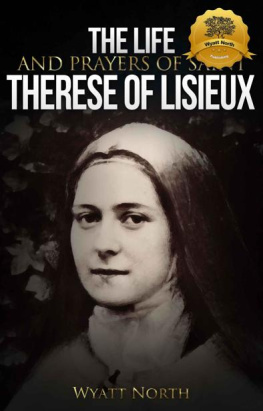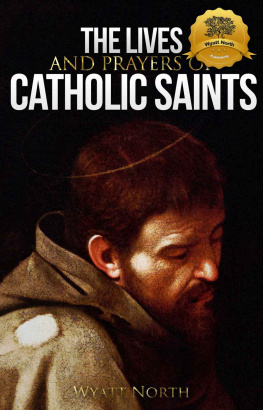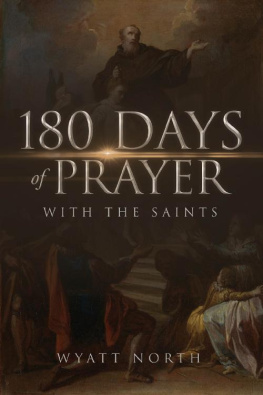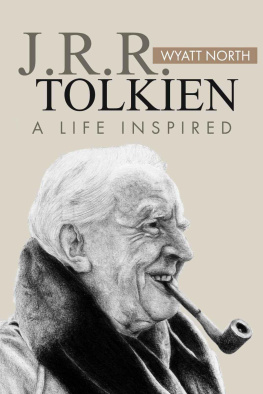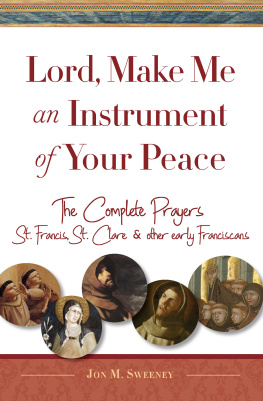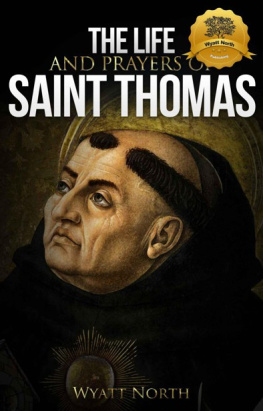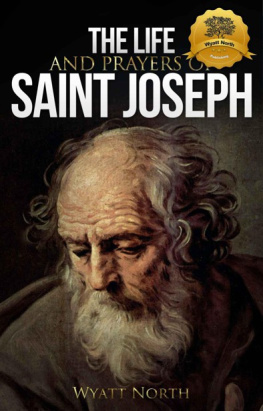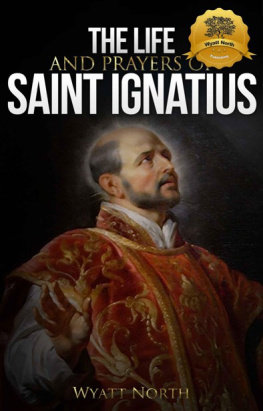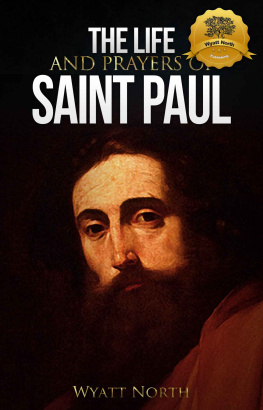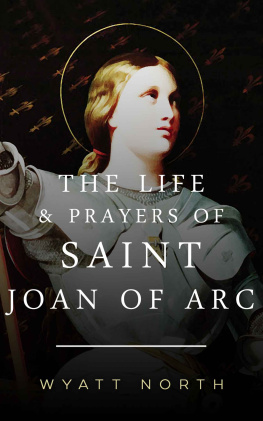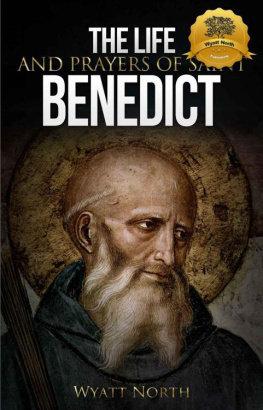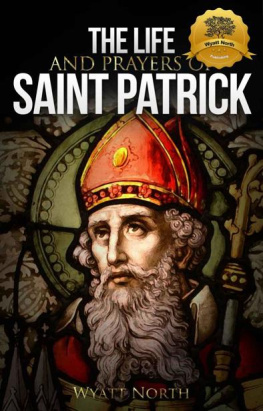The Life and Prayers of
Saint Anthony of Padua
Wyatt North
Wyatt North Publishing

Wyatt North Publishing, LLC 2012
A Boutique Publishing Company
Publishing by Wyatt North Publishing, LLC.
Copyright Wyatt North Publishing, LLC. All rights reserved, including the right to reproduce this book or portions thereof in any form whatsoever. For more information please visit http://www.WyattNorth.com .
Cover design by Wyatt North Publishing, LLC. Copyright Wyatt North Publishing, LLC. All rights reserved.
Scripture texts in this work are taken from the New American Bible, revised edition 2010, 1991, 1986, 1970 Confraternity of Christian Doctrine, Washington, D.C. and are used by permission of the copyright owner. All Rights Reserved. No part of the New American Bible may be reproduced in any form without permission in writing from the copyright owner.
ISBN: 978-1-62278-122-5
About Wyatt North Publishing
Wyatt North Publishing is a boutique publishing company. We always provide high quality, perfectly formatted, eBooks. All of our eBooks include a Touch-or-Click Table of Contents, allowing easy and instant access to each section.
We guarantee our eBooks. If you are not 100% satisfied we will do everything in our power to make you happy. Visit .
Free eBooks in Your InBox
FREE inspirational eBooks for eReader! Never miss a free book from Wyatt North.
Thousands of readers have already joined. Sign up for free today.
Click here for free eBook offers!
Foreword
One part biography, one part prayer book, The Life and Prayers of Saint Anthony of Padua is an essential book for any Christian.
For centuries Saint Anthony of Padua, Thaumaturgist, Evangelical Doctor of the Church, has been regaled and venerated as a wonder-worker, eminent theologian, and preacher. To him infertile women, sailors, the poor, seekers of lost articles, to name a few, have prayed to intercede. Thousands upon thousands flocked to hear him preach, and witnessed his miraculous deeds.
We hope that with this book, the reader might realize an invitation to call upon Anthony, not just to find lost things, but as a companion in a quest to find a renewed and challenged faith, hope, and love.
All books in The Life and Prayers series come complete with a Touch-or-Click Table of Contents, divided by each section.
Touch-or-Click Table of Contents
Century Catholics
The Life of Saint Anthony
The faithful dweller of the hermitage was sent out into the world and his lips, closed for so long, were opened to proclaim the glory of God. The Assidua
I. His Life, His Lessons, His Legacy
T he Lord anointed his servant, Saint Anthony of Padua, and put a call on a boys heart to labor for Gods kingdom until death. This writing is an attempt to illuminate the many facets of this great saint who, over close to eight centuries since his death, continues to inspire and assist.
Perhaps in this book, among a plethora about Saint Anthony of Padua, the reader might realize an invitation to call upon Anthony, not just to find lost things, but to companion with him/her in a quest to find himself/herself renewed and challenged in faith, hope, and love. What better friend and guide than this servant who demonstrated a remarkable balance between inward piety and study, and full engagement in the world into which God placed him. Although canonized more quickly after his death than any other, S. Anthony would be the first to say that anyone can follow in his footsteps by being contemplatively receptive, biblically attentive, and ready to answer to the cries of the needy.
May such an invitation resound in you as you read again, or for the first time, about the life, lessons, and legacy of this great Catholic Saint, Anthony of Padua.
II. His World
F or centuries Saint Anthony of Padua, Thaumaturgist, Evangelical Doctor of the Church, has been regaled and venerated as a wonder-worker, eminent theologian, and preacher. To him infertile women, sailors, the poor, seekers of lost articles, to name a few, have prayed to intercede.
Thousands upon thousands flocked to hear him preach, and witnessed his miraculous deeds. To address S. Anthonys life and work apart from the place and time in which God placed him would be to ignore that he, like all of us, is in part a product of the significant moments and culture of his day. Unlike ordinary mortals, however, Saint Anthony of Padua, by Gods grace, was able to fully engage himself in the world for Gods purposes, tirelessly performing deeds sacred and profane, that left his God-forsaken world a better place.
The span of thirty-seven years of S. Anthonys earthly sojourn (1195-1231) fell within The High Middle Ages, a time marked by population growth not seen before or again until the 1900s, an expansion that shifted every arena in which humans operated. Consider the events unfolding in the land of his birth, Portugal, then referred to as the Iberian Peninsula.
Over centuries Lisbon, where Ferdinand Martins de Bulhoes (S. Anthonys baptismal name) was born, was a European coastal attraction to every sea-faring conqueror from as far north as the Vikings of Scandinavia, to as far away as the Moors. These vastly varied cultures left their footprints on Portugals shores, altering forever the demographic and secular and religious culture of S. Anthonys homeland. Only four decades before his birth, within the seven-centuries-long Reconquista (the struggle of Christians to conquer the Iberian Peninsula from Islamic kingdoms), knights took Lisbon back from Muslim control to restore her to Christianity. This localized struggle reflected events in the wider theatre, the crusades, the ongoing fight between Muslims and Christians for control of Jerusalem, the spiritual epicenter of both religions.
S. Anthony would personally encounter the atrocities of the crusades as an adult, and his familys fidelity to the Church would insure his early Christian formation. With the cross-fertilization of cultures in Lisbon, where Ferdinand spent the first fifteen years of his life, its likely he might have played with the children whose forebears came from faraway lands, vastly different than his own. Perhaps he stood by and watched Christian statues and churches rise from the litter where mosques had been razed in the struggle for Christian dominance.
Four Popes led the Church over S. Anthonys brief span of years on earth. Most likely the greatest influence on his thinking and ministry was Pope Innocent III - although it was Pope Gregory IX who put S. Anthony on the map - whose ability to influence politics in nations across Europe established his papacy as the most renowned of the Middle Ages. Pope Innocent gave audience to and authorized the mendicant order that S. Anthony joined after his eight years as Canons Regular of St. Augustine. The Order of Friars Minor, established by St. Francis of Assisi, was attractive to Pope Innocent for its commitment to a life of obedience, simplicity and chastity.
Not unaware of the slovenly and self-indulgent ways of clergy and laity, The Pope acknowledged those who were loyal to the Church and its doctrine. Innocent IIIs thoughtful and prolific writings during his Papacy and during retirement, and the seventy canons he issued at The Great Council (the Fourth Lateran Council) in 1215, no doubt, influenced S. Anthonys moral and doctrinal theology, especially with regards to the Eucharist. The Popes canon on the Doctrine of Transubstantiation established the belief that the bread and the wine are the actual body and blood of our Lord Jesus.
III. Turning Points
T he following provide important turning points in the life of Saint Anthony.
Next page


